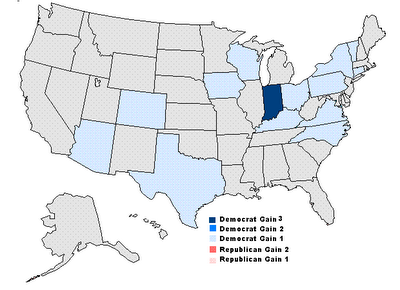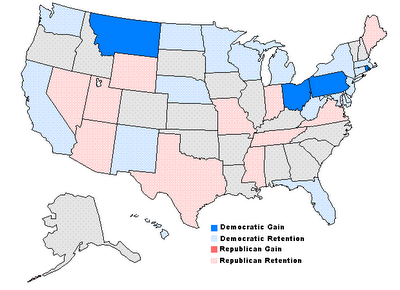Sunday, January 22, 2006
Thursday, January 19, 2006
West Coast Regional Trend
Tuesday, January 17, 2006
Southwest Regional Trend
Sunday, January 01, 2006
National Overview - House
Weak Retention - Total: 12
- J.D. Hayworth, Arizona District 5
- No Incumbent, Florida District 13
- Ron Lewis, Kentucky District 2
- Anne Northup, Kentucky District 3
- Tim Walz, Minnesota District 1
- Michael Ferguson, New Jersey District 7
- John Sweeney, New York District 20
- Randy Kuhl, New York District 29
- No Incumbent, Nevada District 2
- Mike Fitzpatrick, Pennsylvania District 8
- Henry Bonilla, Texas District 23
- Barbara Cubin, Wyoming AL District
Very Weak Retention - Total: 15
- Richard Pombo, California District 11
- Mariyln Musgrave, Colorado District 4
- Christopher Shays, Connecticut District 4
- Nancy Johnson, Connecticut District 5
- Clay Shaw, Florida District 22
- No Incumbent, Illinois District 6
- No Incumbent, Minnesota District 6
- Heather Wilson, New Mexico District 1
- Robin Hayes, North Carolina District 8
- Steve Chabot, Ohio District 1
- Deborah Pryce, Ohio District 15
- Curt Weldon, Pennsylvania District 7
- Don Sherwood, Pennsylvania District 10
- Dave Reichert, Washington District 8
- No Incumbent, Wisconsin District 8
Democrats
Weak Retention - Total: 3
- John Salazar, Colorado District 3
- Leonard Boswell, Iowa District 3
- Charlie Melancon, Louisiana District 3
Very Weak Retention - Total: 4
- Jim Marshall, Georgia District 8
- John Barrows, Georgia District 12
- Melissa Bean, Illinois District 8
- Chet Edwards, Texas District 17
Very Weak Gain - Total: 8
- No Incumbent, Colorado District 7
- Rob Simmons, Connecticut District 2
- Geoff Davis, Kentucky District 4
- No Incumbent, New York District 24
- Charles Taylor, North Carolina District 11
- Robert Ney, Ohio District 18
- Jim Gerlach, Pennsylvania District 6
- Thelma Drake, Virginia District 2
Weak Gain - Total: 7
- No Incumbent, Arizona District 8
- Chris Chocola, Indiana District 2
- John Hostettler, Indiana District 8
- Mike Sodrel, Indiana District 9
- No Incumbent, Iowa District 1
- No Incumbent, Texas District 22
- No Incumbent, Vermont District 1
Northeast Regional Trend
Mid-Atlantic Regional Trend
National Overview - Senate
- Dick Lugar, Indiana
- Olympia Snowe, Maine
- Trent Lott, Mississippi
- John Ensign, Nevada
- Kay Bailey Hutchinson, Texas
- Orrin Hatch, Utah
- Craig Thomas, Wyoming
Moderate Retention - Total: 1
- John Kyl, Arizona
Very Weak Retention - Total: 3
- Jim Talent, Missouri
- No Incumbent, Tennessee
- George Allen, Virginia
Democrats
Solid Retention - Total: 10
- Dianne Fienstein, California
- Tom Carper, Delaware
- Daniel Akaka, Hawaii
- Ed Kennedy, Massachusetts
- Ben Nelson, Nebraska
- Jeff Bingaman, New Mexico
- Hillary Clinton, New York
- Kent Conrad, North Dakota
- Robert Byrd, West Virginia
- Herb Kohl, Wisconsin
Moderate Retention - Total: 2
- Bill Nelson, Florida
- Debbie Stabenow, Michigan
Weak Retention - Total: 3
- No Incumbent, Maryland
- No Incumbent, Minnesota
- Maria Cantwell, Washington
Very Weak Retention - Total: 1
- Robert Menendez, New Jersey
Very Weak Gain - Total: 2
- Mike DeWine, Ohio
- Lincoln Chafee, Rhode Island
Weak Gain - Total: 2
- Conrad Burns, Montana
- Rick Santorum, Pennsylvania
Independents
Solid Retention - Total:1
- No Incumbent, Vermont
Weak Gain - Total: 1
- Joe Lieberman, Connecticut
National Overview - Governor
- Jodi Rell, Connecticut
- Linda Lingle, Hawaii
- No Incumbent, Idaho
- Dave Heineman, Nebraska
- Mike Rounds, South Dakota
- Jim Douglas, Vermont
- Sonny Perdue, Georgia
- Mark Sanford, South Carolina
- Rick Perry, Texas
Weak Retention - Total: 2
- Bob Riley, Alabama
- Frank Murkowski, Alaska
Very Weak Retention - Total: 4
- Arnold Schwarzenegger, California
- No Incumbent, Florida
- Tim Pawlenty, Minnesota
- No Incumbent, Nevada
Democrats
Solid Retention - Total: 4
- Janet Napolitano, Arizona
- John Lynch, New Hampshire
- Bill Richardson, New Mexico
- Phil Bredesen, Tennessee
Moderate Retention - Total: 3
- Bob Henry, Oklahoma
- Ed Rendell, Pennsylvania
- Dave Freudenthal, Wyoming
Weak Retention - Total: 4
- Rod Blagojevich, Illinois
- Kathleen Sebelius, Kansas
- John Baldacci, Maine
- James Doyle, Wisconsin
Very Weak Retention - Total: 3
- No Incumbent, Iowa
- Jennifer Granholm, Michigan
- Ted Kulongoski, Oregon
Very Weak Gain - Total: 3
- No Incumbent, Colorado
- Bob Ehrlich, Maryland
- Donald Carcieri, Rhode Island
Weak Gain - Total: 1
- No Incumbent, Massachusetts
Moderate Gain - Total: 2
- No Incumbent, Arkansas
- No Incumbent, Ohio
Solid Gain - Total: 1
- No Incumbent, New York



